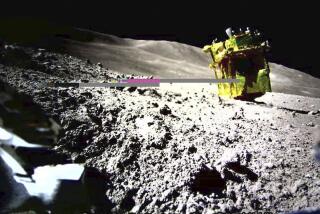After long delay, Japan launches lunar orbiter
- Share via
TOKYO — After a 17-year hiatus between lunar missions, Japan launched an unmanned orbiter today that carries the hopes of a nation looking to claim its place as a serious space power.
Taking advantage of a lull in rainy weather, the Kaguya orbiter lifted off from Tanegashima island in southern Japan, propelled by a domestically built H-2A solid-fuel rocket. Its 21-day trip to the moon begins a yearlong mission that Japan’s civilian space agency, known as JAXA, is promoting as the most significant lunar expedition since America’s Apollo program of the 1960s and early ‘70s.
The mission comes at a crucial time for Japan’s space program. JAXA faces accusations that it lacks a vision capable of challenging China’s accelerating space ambitions in the nations’ rivalry for leadership in East Asia. And the agency finds itself competing for the favor of Japanese politicians now more inclined to back defense-related space programs, such as completing a network of spy satellites and joining with the U.S. to develop a ballistic-missile shield.
JAXA is hoping that the long-delayed launch of the three-ton, $480-million Kaguya will be a step toward rekindling excitement in Japan for the scientific side of space exploration. The satellite is projected to descend into orbit 60 miles above the moon’s surface, mapping uncharted polar areas, examining the makeup of the soil and searching for signs of ice. It also carries a high-definition TV camera provided by national broadcaster NHK, which is expected to send back dramatic images of the moon, and of Earth from the moon.
“We learned a lot from Apollo, but the landing points were all near the equator and on the front side of the moon,” says Seiichi Sakamoto, a professor of space science at JAXA. “Now it is time to do something really interesting, to complete the imaging and even to look at where to put future facilities for a manned base.”
But the Japanese public has yet to show similar enthusiasm for the adventure. Despite technological prowess that made Japan, in 1972, the fourth country to put a satellite into orbit, the country’s space program has more recently been beset by a series of launch failures and technical problems.
In fact, the Kaguya launch follows the scrapping of another planned Japanese moon mission that never got off the ground. The Lunar-A probe was supposed to go to the moon in 1995, sending two separate sensors to the surface to dig for soil samples. But JAXA scientists were never able to develop the drill needed to penetrate the ground and, after a decade waiting on the shelf, the main satellite became unusable.
This kind of embarrassment has prevented JAXA from mustering enough popular support to insulate it from government-wide cuts in public works spending. And the civilian space program is held in such low esteem that JAXA is forced to negotiate with local fishermen off Tanegashima for acceptable launch times. Today’s liftoff was scheduled during typhoon season because September was one of two launch windows offered by the fishermen’s unions.
“JAXA is only now realizing it has to push the space program in ways that appeal to the public if they want to re-enhance the political importance of space,” said Kazuto Suzuki, a specialist in global space issues at Tsukuba University in Tokyo.
But the Chinese are helping accomplish what JAXA has not. China has sent two manned missions into Earth orbit and has lunar ambitions of its own.
In October, it plans to launch the Chang’e 1 orbiter to, among other things, take 3-D pictures of the moon’s surface. The probe is part of a 10-year program that Chinese officials say will include a lunar rover and a mission to pick up geological samples.
It is the precarious security situation in East Asia that is really driving any renewed Japanese interest in space. Japan was jolted into developing a separate, security-related space program by North Korea’s launch of ballistic missiles over its territory in 1998 and, since then, has launched four spy satellites to provide a 24-hour watch over its neighbor.
There is also a growing awareness that Japan will need more communications satellites if it continues to send its Self-Defense Forces into distant theaters.
That leaves the civilian program in need of a clear mission that can compete for public support and funding. Some argue that unmanned lunar probes may not be enough to woo the public in an age when billionaire tourists can buy a ticket to ride a Russian space capsule and Google is offering a $20-million prize for an amateur race to the moon.
Suzuki argues that Japan should use its technological edge to carve out a leadership role in Asia by emphasizing space programs with practical applications, such as the Advanced Land Observing Satellite it launched in 2006 to assist with disaster relief.
“JAXA has been too focused on fantastic, futuristic things,” Suzuki said. “They have people who want to go to the moon, or Mars, or to asteroids, and the Kaguya program is a holdover from that past.”
--
More to Read
Sign up for Essential California
The most important California stories and recommendations in your inbox every morning.
You may occasionally receive promotional content from the Los Angeles Times.













